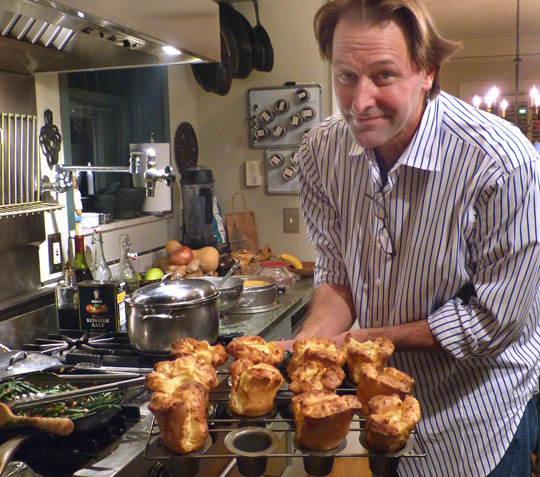No one is happier than I finally to have some routine again, tree taken down, kids in school, and a plunge back into work with all kinds of exciting projects on the horizon.
But I can't stop thinking about these Yorkshire puddings. I'm always surprised by popovers, how simple they are, and how dramatic they can be. The first time I made Yorkshire pudding for Christmas dinner, it was at Dad's house and I simply poured the batter into the baking dish the roast beast had cooked in. I marveled at its lava-lamp convolutions as it cooked.
I love the simplicity of the basic popover, which is all this is (here with some savory mustard). This post and photo long ago inspired readers as far away as India to make breakfast popovers: flour, egg and milk, poured into whatever vessel they had on hand, a ramekin, a coffee mug. There's magic in simplicity. Just look at the original photo.
I was completely unprepared, though, to have created this year what turned out to be the Ethel Mermans of the popover world this past Christmas and had to share the photo that Donna, in the midst of pouring wine and readying serving platters, insisted on taking, as we were all rather astonished by these show-stopping Yorkies, as my recipe maven Marlene Newell calls them (she introduced these in a guest post, and I include this recipe in Ruhlman's Twenty).
What accounted for their uncommon height? Arrogance perhaps? A because-I-just-couldn't-help-myself flamboyance worthy of Cam on Modern Family? I have no idea. But here's what I did. The batter was made many hours in advance so that the flour was well hydrated. The pan was hot. I'd rendered the beef suet the day before and this too was very hot. I didn't skimp when I poured the fat into the pan, a good tablespoon per. I filled the cups three-quarters up.
I did take one further step. Upon realizing that I had popover prodigies in my hands, I performed a final step I don't normally do but felt obliged to do here, lest these babies fall on me. I can't remember where I read it, but I knew it was worth the trouble here. Trapped steam (what makes them puff) can soften the interior to the extent that they collapse. I felt morally obligated to prevent this. So I pierced each down through the center with a paring knife immediately after Donna shot the above photo, then returned them to the oven for a few more minutes. The piercing releases the steam and the final minutes in the heat sets the interior structure.
Et voila!
So back to work with best wishes to readers and cooks for a year filled with culinary magic.
Marlene’s Yorkshire Pudding
(adapted for the Ruhlman household)
- 2 cups/280 grams all-purpose flour
- 1 tablespoon mustard powder
- 9 or 10 large eggs
- 2 cups/450 milliliters whole milk
- four-finger pinch of salt
- 4 to 6 ounces/120 to 180 milliliters vegetable oil or beef fat drippings
Equipment
- one 12-well mini-popover pan or 12-cup muffin pan
- Sift the flour and mustard powder together into a large bowl. Add the eggs and milk and blend on high speed with a hand mixer until fully incorporated. Let the batter rest for 2 hours at room temperature, reblending now and then.
- Preheat the oven to 450°F/220°C.
- Place 1 tablespoon fat in each cup of a popover pan or ½ teaspoon fat in the well of each muffin cup. Place the pan on a baking sheet and slide it into the oven to heat the oil while the oven is heating. When the oven has reached temperature, reblend the batter, remove the pan, and pour the batter into the cups, dividing it evenly and filling the cups three-fourths full. Place the pan in the oven and turn on the light so you can watch them rise. Bake until the puddings are puffed and golden brown, 15 to 25 minutes depending on your oven. To prevent their falling when they cool, pierce each with a pairing knife and return the pan to the oven for a few more minutes. Serve immediately.
- My post on preparing a grilled and roasted prime rib.
- How about making a popover sandwich with a fried egg and creamed spinach.
- Interesting facts about Yorkshire pudding or the "dripping pudding."
- Can you become a chef in four hours?
© 2013 Michael Ruhlman. Photo © 2013 Donna Turner Ruhlman. All rights reserved.



Looks amazing!!
There is an error in your recipe. You start by preheating to 450 but then after ten minutes you reduce temp to 450.
Is the preheat higher or the reduce heat lower?
Marlene starts hers at 475, then reduces. I did it at 450 this year and it worked fine.
I added chives to mine this year.
Love that idea.
I believe it is the mustard powder that helps give it such structure. I never pierce mine, but may try that next time. Sometimes when they are done, I will just turn the oven off and let them sit for 5 minutes. Mine don't deflate. And yes, I do start mine at 475. it does make the oven smoke somewhat though when heating up that oil!
and where did you get a 12 cup popover pan Michael, or is that a mini popover pan?!
I didn't know there were maxis!
These really do look amazing. Definitely going to try this with my next roast beast dinner.
Them be some pretty yorkie puddings!
I added the salt to flour & dry mustard. I hope that’s where it should go, prepping tomorrow’s dinner & will see how it goes.
Cheers, merry & happy all!
you did right, sorry for the lack of info!
Oh, and I'm pretty sure it was Jayden of Steamy Kitchen who talked about the piercing thing but I could be wrong.
Alton Brown does it in his recipe.
I am adding a new Resolution. Don't read this blog at lunchtime.
Have you been to the popover restaurant in manhattan? On Amsterdam just next to Barnie Greengrass, The Sturgeon King. Huge popovers.
I've never tried popovers because I don't have - and don't plan to get - a popover pan or appropriately sized/shaped ramekns. You can just make the thing in a regular muffin pan? Isn't the tall, narrow shape of the popover pan essential?
you can use anything you want! mini ones in espresso cups, big ones in muffin pans, anything that won't break in the high heat.
I've been meaning to try popovers for a while now. This photo has convinced me. Better go pick up some good Irish butter...
Hmmmm. I made a pronouncement at Christmas dinner this year (prime rib, yorkshire pudding) that I didn't really care that much for yorkshire pudding and perhaps wouldn't be making it again. Mine came out, once again, like a very thick, dense, bland pancake. I use Ramsey's recipe and drippings, not veg oil. I made the batter in advance, like you said. But no mustard powder in the recipe. Is that what I'm missing (per Marlene above)? And I do it in one pan. Do the muffin/popover pans make a big difference as well?
Kristine, I just looked up Ramsey's recipe and if it is the same one you're using, he says to bake them at 425. That is just not hot enough in my opinion. I think the mustard powder does make a difference and I think he's got too much milk and flour. The ratio for these is 1:1:1: So I'm using the same 4 eggs he does, but less flour and milk.
I cup eggs (4 large eggs)
1 cup flour
1 cup milk.
Plus the mustard powder.
As Michael notes, resting the batter a couple of hours ahead of time at room temp is pretty critical, and mix it again just before you put it in the hot oil. You should be able to do this in one pan no problem, but it will not rise as high as popover pans. Muffin pans work pretty well and I used them for years before aquiring a popover pan.
Thanks, Marlene. I'm going to try your method. Your comments on his recipe make sense, considering the results I've been getting. I think I'll try it this weekend when I'm not scrambling around trying to do a hundred other things.
I used the pierce and bake for 5 more minutes technique when I made gougeres. Letting out the steam does help them hold up and I imagine it's more important when they are done in a popover pan since the sides aren't exposed to the drying oven heat.
I have lots of suet in my freezer from my brother who raises grass fed beef. How would I render it for these popovers? The suet has been ground. I have used the suet for the fat in pie dough to make a beef pie, yum.
Hey Melanie ... chop it and put it in a pot with lots of water. Bring it to a boil, reduce to simmer and simmer for a couple of hours. Then put it somewhere cold until the rendered fat rises and hardens and then remove the rendered fat. Easy!
I cut suet into a medium dice and start it in water over low heat and forget about it till i smell it. the water cooks off and the fat renders.
Paul's method is fascinating--hadn't thought of that. It will result in a much milder tasting fat. Mine approaches a roasted flavor. I would use his method for lard and mine for suet!
Can you use bacon grease for the fat for the popovers?
It must've been an English kind of Christmas, we did Yorkshire pudding too! I follow my mom's recipe, she always said, "Let the batter rest out on the counter for a couple of hours, it just makes all the difference". I was reminded of that when I made another batch after Christmas and didn't -- the Yorkshires were heavy and doughy and just not very appealing. A popover pan isn't required -- and we always use bacon grease vs oil. I love throwing in some beef drippings but it's not necessary.
The only error I see in the above is that you only have 11 popovers. The caption reads that you wee serving dinner for eleven. Why such austerity with the popovers, Ruhlman?
The catering company I work for makes mini Yorkshires appetizers. They are stuff horseradish cream and braised short ribs. When needed, we then reheat them until slightly crisp. A big favourite with our customers.
This Yorkshire Pudding looks very delicious. Thanks for the idea.